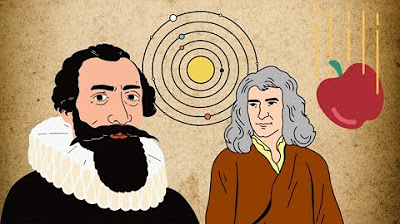The Infinite Pattern That Never Repeats
Summary
TLDRThis video explores the fascinating world of impossible patterns and materials, starting with Johannes Kepler's theories on planetary orbits and his geometric model of the solar system. It delves into Kepler's conjecture on the efficient stacking of cannonballs and his musings on snowflakes' hexagonal patterns. The narrative then transitions to the concept of aperiodic tiling, exemplified by Roger Penrose's discovery of a pattern that can tile a plane without repeating. This leads to the groundbreaking discovery of quasi-crystals, which defied traditional crystallography and were ultimately recognized with a Nobel Prize. The video ponders the unseen possibilities that challenge our perceptions of the impossible.
Takeaways
- 📘 Johannes Kepler is renowned for discovering elliptical planetary orbits but initially proposed a solar system model using nested spheres and Platonic solids.
- 🔍 Kepler's interest in geometry led him to solve practical problems like the efficient stacking of cannonballs, which he determined could be optimally packed in a hexagonal close packing or face-centered cubic arrangement.
- 🌨️ In his pamphlet 'De Nive Sexangula', Kepler pondered the reason behind the consistent six-cornered shape of snowflakes, hinting at a deeper understanding of crystalline structures.
- 🔲 Kepler's conjecture on the most efficient sphere packing was unproven during his lifetime but was confirmed to be correct in 2017, approximately 400 years later.
- 🔷 The concept of regular hexagons tiling a plane periodically with no gaps was understood by Kepler, who also explored the impossibility of regular pentagons achieving the same.
- 🔺 Roger Penrose's work on aperiodic tiling with two shapes, kites and darts, challenged traditional periodic tiling patterns and introduced a new form of non-repeating patterns.
- 🛠️ Penrose's tiling patterns, although not initially believed to have a physical analog, were later found to be mirrored in quasi-crystals, a discovery that earned Dan Shechtman the Nobel Prize in Chemistry.
- 🔬 The discovery of quasi-crystals, materials that display five-fold symmetry and do not fit into traditional crystallography, was a breakthrough that expanded our understanding of solid materials.
- 🔄 The Fibonacci sequence and the golden ratio are naturally embedded within Penrose's tiling patterns, showcasing the interconnectedness of mathematical constants and geometric patterns.
- 🔑 LastPass, a password management tool, was highlighted as a sponsor, emphasizing the importance of secure password practices and the convenience of password management for users.
Q & A
What is Johannes Kepler most famous for?
-Johannes Kepler is most famous for figuring out that the shapes of planetary orbits are ellipses.
What was Kepler's initial model of the solar system before discovering elliptical orbits?
-Kepler initially invented a model where planets were on nested spheres separated by the Platonic solids.
What are the five Platonic solids?
-The five Platonic solids are the tetrahedron, cube, octahedron, dodecahedron, and icosahedron.
What is Kepler's conjecture regarding the stacking of cannonballs?
-Kepler's conjecture states that hexagonal close packing and the face-centered cubic arrangement are both equivalently and optimally efficient for stacking cannonballs, occupying about 74 percent of the volume they take up.
What was Kepler's pamphlet 'De Nive Sexangula' about?
-Kepler's pamphlet 'De Nive Sexangula' pondered why snowflakes always form six-cornered shapes and speculated about the self-arrangement of water molecules into hexagonal crystals.
What is the significance of hexagons in tiling a plane?
-Hexagons can cover a flat surface perfectly with no gaps, a property known as periodic tiling, and they have six-fold symmetry.
What is an aperiodic tiling?
-An aperiodic tiling is a set of shapes that can tile the plane without ever repeating the same pattern, such as the Penrose tiling.
How did Roger Penrose simplify the Penrose tiling?
-Roger Penrose simplified the Penrose tiling to just two shapes: a thick rhombus and a thin rhombus, with rules enforced by bumps and notches or matching colors.
What is the connection between Penrose tiling and the golden ratio?
-The ratio of kites to darts in Penrose tiling approaches the golden ratio, which is an irrational number and provides evidence that the pattern cannot be periodic.
How did the discovery of quasi-crystals challenge the existing understanding of crystals?
-Quasi-crystals, which exhibit five-fold symmetry, challenged the existing understanding that crystals must have one of the 14 known unit cells and cannot have long-range order without repeating patterns.
What was Linus Pauling's initial reaction to the concept of quasi-crystals?
-Linus Pauling famously remarked, 'There are no quasi-crystals, only quasi-scientists,' expressing skepticism towards the concept of quasi-crystals that defied the laws of nature at the time.
Outlines

Dieser Bereich ist nur für Premium-Benutzer verfügbar. Bitte führen Sie ein Upgrade durch, um auf diesen Abschnitt zuzugreifen.
Upgrade durchführenMindmap

Dieser Bereich ist nur für Premium-Benutzer verfügbar. Bitte führen Sie ein Upgrade durch, um auf diesen Abschnitt zuzugreifen.
Upgrade durchführenKeywords

Dieser Bereich ist nur für Premium-Benutzer verfügbar. Bitte führen Sie ein Upgrade durch, um auf diesen Abschnitt zuzugreifen.
Upgrade durchführenHighlights

Dieser Bereich ist nur für Premium-Benutzer verfügbar. Bitte führen Sie ein Upgrade durch, um auf diesen Abschnitt zuzugreifen.
Upgrade durchführenTranscripts

Dieser Bereich ist nur für Premium-Benutzer verfügbar. Bitte führen Sie ein Upgrade durch, um auf diesen Abschnitt zuzugreifen.
Upgrade durchführenWeitere ähnliche Videos ansehen

Science Questions: What is Kepler's Third Law?

Sistem Tata Surya : Matahari - Planet - Komet - Meteoroid - Asteroid - Benda Langit

The New Astronomy: Crash Course History of Science #13

Lesson 3 - Lecture 1 - Understanding Orbits - Tycho & Kepler - OpenStax

[APLIKOM] Tugas Proyek Animasi: Hukum Keppler

Las leyes de Kepler - Fer Fer González (La mejor explicación)
5.0 / 5 (0 votes)
